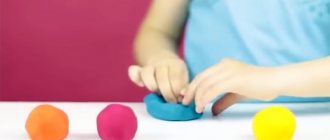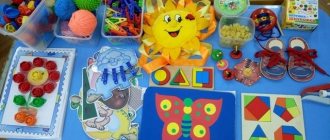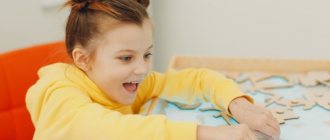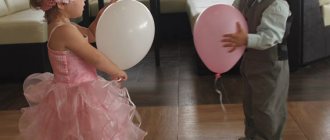What does it mean to develop fine motor skills?
Fine motor skills are the ability to reproduce precise movements with the hand and fingers.
This is important not only for developing beautiful handwriting, we must also remember that the phalanges of the fingers are the main tools in the work of representatives of many professions. The development of fine motor skills in children aged 6-7 years is facilitated by drawing, playing musical instruments, working with plasticine and small construction sets. But the greatest effect is obtained as a result of special classes. The exercises offered to children help develop accuracy and speed of movement. As a result of their implementation, the hands and fingers will become stronger, flexible and mobile. There are three types of such tasks:
- exercises with small objects;
- graphic tasks;
- finger games.
In light of preparing for school, the greatest attention should be paid to completing graphic tasks. Children must learn to hatch and draw lines of different thicknesses and shapes. At the same time, it is necessary to ensure that they draw lines without lifting the pen from the paper, do not go beyond the designated contours, do not leave spaces, perform movements correctly (from top to bottom, left to right), do not turn the notebook, and sit correctly at the table.
Classes to develop fine motor skills of the hands should be carried out regularly, studying for 10 - 20 minutes a day. Monotony and monotony should not be allowed; during the lesson, children should be offered several different exercises with exciting game content. To do this, the teacher and parents are invited to use a card file of exercises for the development of fine motor skills in children 6 - 7 years old.
MAGAZINE Preschooler.RF
Non-traditional technologies for the development of fine motor skills.Parents and teachers are always concerned with the question of how to ensure the full development of a child in preschool age, how to properly prepare him for school? An important and integral part of a child’s development is work on developing fine motor skills.
The development of fine motor skills of the hand is of great importance for the overall mental and physical development of the child throughout preschool childhood. This has been repeatedly emphasized by psychologists, teachers, and physiologists. Famous teacher V.A. Sukhomlinsky wrote: “The sources of children’s abilities and talents are at their fingertips. From the fingers, figuratively speaking, come the finest streams that feed the source of creative thought . In other words, the more skill a child has in his hand, the more developed the child is. In addition, scientists have proven that the development of the hand is closely related to the development of the child’s speech and thinking. Typically, a child who has a high level of development of fine motor skills is able to reason logically, his attention, memory, and coherent speech are sufficiently developed. It follows that exercises to develop fine motor skills are necessary for children.
It is not advisable to conduct joint classes to develop fine motor skills only in the form of separate mechanical exercises. Children must first be interested in some feasible type of activity, during which conditions must be created to prepare their hands to perform various movements. In order for the children to enjoy learning, we chose to work with paper.
The influence of working with paper on the development of thinking and intelligence was studied by psychologists from Rostov-on-Don, Ekaterina and Yuri Shumakov. They concluded that such activities:
- increase the activity of the right hemisphere of the brain, balance the work of both hemispheres;
- increase the level of intelligence in general;
- activate creative thinking;
- increase and stabilize the psycho-emotional state at a high level;
- reduce anxiety and help you adapt more easily to difficult situations;
- improve motor activity of the hands, develop finger motor skills;
- improve memory and eye.
Therefore, work on developing the fine muscles of the arms should begin long before entering school.
Along with traditional techniques, such as applique, origami, papier-mâché, we persistently introduce the latest technologies for working with paper, including: Iris - folding, Quilling, Decoupage, Trimming, Kirigami.
Iris folding
The name of this technique, translated from English, means folding the iris, iris folding. That’s why my children and I call this technique the iris. The design is filled with thin paper strips, which, overlapping each other at a certain angle, create an interesting twisting spiral effect. In iris folding, you can use special paper for this technique, regular colored paper, velvet paper, gift wrapping paper, colored foil, in general, depending on your imagination.
Technique:
- The required fragment of the picture is cut out along the contour.
- On the reverse side, strips of colored paper are glued onto the drawing strictly in a certain order, in accordance with a pre-prepared template or a diagram drawn up by you.
- The wrong side is sealed with a clean sheet of paper.
- The drawing, if necessary, is supplemented with details.
When performing work using this technique, children must adhere to the following rules:
- Paste the strips in accordance with the diagram in a strictly defined order;
- Glue the ends with small pieces of tape;
- Avoid omissions;
- The fold of the strip should always be in one direction, towards the center.
The following works were completed using this technique: “Autumn Leaves” , “Ripe in the Garden...” , “Nice Mushrooms” , “Postcard for Santa Claus” , “He Runs in the Waves” , “In the Aquarium” .
Quilling
In English, this needlework is called “quilling” - from the word “quill” or “bird feather” . The art of paper rolling originated in Europe in the late 14th and early 15th centuries. In medieval Europe, nuns created elegant medallions by twisting paper with gilded edges onto the tip of a bird's feather. When viewed closely, these miniature paper masterpieces created the complete illusion that they were made of thin gold strips. Unfortunately, paper is a short-lived material and little has survived from medieval masterpieces. However, this ancient technique has survived to this day and is very popular in many countries around the world.
In South Korea, there is an entire Association of Paper Art Lovers, uniting followers of various areas of paper art.
To make strips we use A-4 printer paper. First, we introduce children to the different elements from which an image can be composed. Then children can create images themselves using familiar elements. Children enjoy paper rolling. Using this type of creativity, the children and I completed the following work:
“Fish in an Aquarium” , “Flowers in a Basket” , “Hot Countries” , “In the Meadow” , “Sunflowers” , “Christmas Tree” , prepared work for the exhibition “For Dear Mommy” .
Decoupage:
The word decoupage is of French origin, meaning "to cut" . Therefore, the decoupage technique is a technique of decoration, decoration, design using cut out paper motifs. This decoration technique was invented by Chinese peasants in the 12th century; it was they who made thin colorful paper and began to decorate various objects with it. This interesting method of decoration came to Europe in the 17th-18th centuries along with beautiful lacquer Chinese furniture, when the fashion for the “East” . Sellers could not meet the huge demand, and the production of counterfeits began. And the decoupage technique spread throughout Europe. Even famous artists such as Matisse and Picasso used decoupage in their works. Currently, three-layer napkins have become the most popular material, which is why in many languages decoupage is called the napkin technique.
Technique for performing the work:
- A motif is cut out from a napkin;
- A composition is compiled;
- The surface to be decorated is coated with PVA glue;
- Cut out napkin motifs are laid out on the glue;
- The top of the napkin is once again covered with PVA glue or beaten egg white.
We used this technique to decorate the dishes.
Trimming-
This technique is familiar to many. On the drawing drawn with a simple pencil, glue a stick (a paper square with a side of 1 cm). We wrap the square around the rod, dip it in glue and glue it to the picture, first this is done along the contour, then inside. The end pieces need to be placed very tightly to make it neat. There are several types of trimming:
- Trimming on paper (with glue, with double-sided tape)
- Trimming on plasticine
- Trimming on ceiling tiles
“The bullfinches have arrived” , “Bouquet of flowers” , “New Year’s cards” are made by trimming.
Kirigami -
This is a modern form of Japanese art, a type of origami that allows the use of scissors and cutting paper in the process of making the model. This is the main difference between kirigami and other paper folding techniques, which is emphasized in the name: (kiru) - cut, (kami) - paper. The simplest and most famous product made using this technique is New Year's snowflakes.
There are many reasons for the success of the classes:
- firstly, it is the paper itself with its familiar, non-aggressive status. You can do whatever you want with paper: crumple it, tear it, draw on it. Motivation appears, a desire to learn how to make various paper crafts.
- the result is achieved quickly.
- there is a predicted positive result - if you carefully and accurately follow all the rules, the craft will definitely turn out beautiful and bright.
- there is the opportunity to manage the process,” that is, to make changes to the figure at will, to invent many of your own models.
- The repetition method and rhythm balance the child’s mental state.
- The most valuable thing is not the final product - a craft, but the development of personality: the formation of self-confidence in one’s abilities, self-identification in creative work, purposefulness of activity.
Only painstaking work, a patient attitude, encouragement during failures, rewards for the slightest success, and unobtrusive help helped us achieve good results. Children enjoy participating in city exhibitions, discussing what technology they will use and what they will do. We started working better with scissors. Voluntary visual attention is more developed, memory has improved, children have become more diligent, careful, and are learning to clearly express their thoughts. And all this directly prepares them for success in school. Non-traditional technologies make it possible to do this in a fun, entertaining way and support children’s interest in manual labor.
| Next > |
Graphic tasks
Most of these tasks are performed on prepared cards. You can purchase special notebooks, copybooks, and coloring books.
Outlines
The card contains the outlines of objects and a pattern of shading (vertical, horizontal, oblique). The direction of the lines is indicated.
Children need to shade the drawings, trying not to go beyond their contours and make even spaces between the lines.
Rain
The picture shows clouds and flowers below. Children are asked to water the flowers so that they do not wilt. To do this, they need to draw lines. This task can be performed several times, each time offering a picture with different types of lines.
Waves
You need to circle the boat and draw waves on the water. Please note that the lines are of different types (straight and curved).
Fish
You should complete the lines of the fins and scales.
Patterned shading
The card contains examples of curly lines. Children must place a pencil on a dot and draw a line to complete the patterns. The main thing is to try not to lift the pen from the paper until the line is completed.
Complete the drawing
Children will enjoy completing tasks to complete the pictures:
- complete the cage for the tiger cub;
- complete the pyramid, shade every second ring;
- complete the butterfly, etc.
Connect the dots
It is necessary not only to draw lines in the desired direction, but to draw the grass near the house by connecting the dots in pairs. In a more complex version, it is proposed to connect all the points with one line.
Develop your eye
In such tasks, you need to try to draw lines between objects yourself. At first, children are given easier tasks when they need to draw arched curved lines. It is much more difficult for children to draw straight lines so that they hit the target as accurately as possible.
- help the bunny jump over the bumps;
- hit the ball in the basket;
- help restore the volleyball net;
- hit the target in the shooting range.
- Draw with pressure
- In this task you need to perform shading using the correct pressure:
- shade the clouds so that one is darker and the other is lighter;
- shade the glasses - one with water (it’s almost transparent), the other with juice (much darker);
- Shade the leaves, making them different in color intensity.
Repeating the pattern by cells
For such a task, cards lined in a cage are prepared. At the beginning of the line, the “rhythm” of the pattern is set, which you need to repeat independently until the end of the line.
Graphic dictations
You can invite children to perform graphic dictations on checkered cards. In such tasks, the number of cells and the direction of movement of the line are indicated. If the dictation is completed correctly, an image of some object appears on the card. Read more about How to conduct graphic dictations in kindergarten.
Games with objects
Usually young children are protected from playing with small objects. After all, they can put them in their mouth or put them in their ear. However, after 5 years such classes are simply necessary.
Games with sand and granular substances
Children can be given the following tasks:
- pour sand from one container to another;
- pour sand with a measuring spoon;
- sift sand through a sieve;
- finger painting in the sand;
- modeling from wet sand;
- searching for buried small objects in the sand.
The most exciting activity in this series is creating crafts from colored salt.
Games with cereals and seeds
Cereals have a coarser texture than sand. Therefore, they can be used for sorting. To do this, take a handful of cereals or seeds of three different types and pour them into one pile. The child is given three small containers into which he must place the grains. This can be done with your fingers or use tweezers.
In another game, children are asked to determine which grains are by touch. To do this, they are scattered into small fabric bags that are tied tightly. You need to take the bag and, having crushed it in your hands, name the cereal.
You can make pictures from cereals and seeds and create applications on plasticine.
Games with buttons
The buttons are larger. They are also suitable for sorting (by size, shape, color). In addition, buttons can be used to lay out ornaments, paths, lines according to a given pattern, pictures.
take on vector
A very interesting task is to fill in the circles in the picture with buttons, matching them by color.
Games with ropes
Games with ropes and laces are great for developing fine motor skills in children. They can be used for tying and untying knots, braiding or macrame.
The task associated with stringing beads is very useful. It’s better to make these “beads” yourself by cutting cocktail tubes. You can specify the exact number of beads that need to be strung or ask to create a beautiful pattern from them, alternating them by color.
Many games involve lacing. Such tasks can often be found on the pages of educational books made from felt.
Games with paper
When working with paper, offer children the following tasks:
- crumpling and smoothing a sheet of paper;
- folding origami.
A very fun game of creating a planned mess. First, children are asked to tear colored paper into small pieces, and then make colorful rain out of them by throwing them into the air. After the active phase of the game, you need to ask the kids to help collect all the scraps, which is also very useful for the development of fine motor skills. These pieces can be used for torn applique. During this game, invite children to tear paper of different thicknesses (from newspapers to cardboard).
Games with clothespins
The set should contain clothespins of different colors. Also, for such games you need to prepare different templates. You can offer the following tasks:
- attach needles to the hedgehog;
- add rays to the sun;
- do a boy's hair.
Games with clothespins are very popular in math and reading classes, so you can combine these types of activities and ask children to use clothespins to:
- count examples;
- attach the appropriate number of clothespins to the number template;
- indicate the required letter.
Games with matches
Although matches are not a toy for children, they can be used for activities to develop fine motor skills by giving the following tasks:
- moving from stack to stack;
- laying out the figures drawn in the picture from matches;
- folding into a box.
Children love to assemble matches into a cube with a small hole in the center of one of the faces. You can use cotton swabs instead of matches.
Non-traditional methods for developing fine motor skills in preschoolers in kindergarten
Non-traditional methods for developing fine motor skills in preschool children.
Contents Introduction 1. Equipping a subject-based development space for the development of fine motor skills in preschool children 2. Games and exercises for the development of fine motor skills of the hands. 3. Little-known non-traditional methods for developing fine motor skills of the hands Conclusion
Non-traditional methods for developing fine motor skills in preschool children.
With the introduction of the Federal State Educational Standard (FSES), education in preschool educational institutions is considered not as a preliminary stage before schooling, but as an independent important period in the life of a child, as an important milestone on the path of continuous education in a person’s life.
The problem of developing fine motor skills in children of primary preschool age is reflected in the “Federal State Standard of Preschool Education”. Presented in the target guidelines at the stage of completion of preschool education “The child has developed fine motor skills.” The problem of developing manual skills and fine motor skills is also important for the personal development of the child himself. By owning a hand, a child in the process of his development becomes more independent, autonomous and independent from an adult, which contributes to the development of his initiative in various types of children's activities. New educational programs for preschool educational institutions are aimed, first of all, at the comprehensive development of the child based on special, specific types of activities inherent in preschoolers. That is, in practice, we received a more playful and versatile approach, welcoming the maximum use of innovative and active methods of pedagogical interaction, more individualized and aimed at unlocking each child’s own potential. Dictating pedagogy has finally been completely eliminated and will be replaced by more modern pedagogy of development, pedagogy of creativity and freedom. Today, dear colleagues, I would like to share my work experience taking into account the implementation of the Federal State Educational Standard. Fine motor skills are the ability to perform precise, coordinated movements with the fingers and hands. Fine motor skills are not only necessary in everyday life, they have a great impact on the child’s learning process. That is why, when diagnosing readiness for school, much attention is paid to how well the fine motor skills of preschoolers are developed. In everyday life, every minute we have to perform fine motor skills: fasten buttons, tie shoelaces, hold cutlery. Fine motor skills are important when learning to write and draw: a person’s handwriting will, in particular, depend on the degree of development of these skills. In addition, the development of fine motor skills is closely related to the development of speech, since the areas of the cerebral cortex responsible for these functions are located very close to each other. It is in preschool age that special attention should be paid to the development of fine motor skills: by the time the child goes to school, his motor skills must be developed at a sufficient level, otherwise learning at school will be difficult for him. Working with preschool children, I am faced with such problems of children as poor development of the hands, poor memory of colors, shapes, impaired hand motor skills; in such children, slowness in performing movements predominates, and stiffness is observed. When completing tasks, the child begins to be capricious and his mood deteriorates. Understanding the importance of this problem, I set a goal for myself: to develop fine motor skills and hand coordination in preschool children through various activities, through didactic games and toys. The group has created the necessary subject-development environment, purchased games and aids for the development of fine motor skills, many of them made with their own hands. Goal: Development of fine motor skills and coordination of hand movements in preschool children through various types of activities, improving conditions for the development of fine motor skills of the fingers of preschool children. Objectives: - Improve coordination and accuracy of hand and eye movements, hand flexibility, rhythm;
— Improve fine motor skills of fingers and hands; — Improve general motor activity; — Promote the normalization of speech function; — Develop imagination, logical thinking, voluntary attention, visual and auditory perception, creative activity; — Create an emotionally comfortable environment in communication with peers and adults. Relevance.
At the initial stage of life, it is fine motor skills that reflect how the child develops and indicate his intellectual abilities. Children with poorly developed manual motor skills awkwardly hold a spoon or pencil, cannot fasten buttons, or lace up shoes. It can be difficult for them to collect scattered parts of the construction set, work with puzzles, counting sticks, and mosaics. They refuse modeling and appliqué, which other children love, and cannot keep up with the kids in class. Thus, the possibilities for children to explore the world are impoverished. Children often feel incompetent in basic activities available to their peers. This affects the child’s emotional well-being and self-esteem. Over time, the level of development shapes school difficulties. And, of course, in preschool age, work on developing fine motor skills and coordination of hand movements should become an important part of the development of children's speech, the formation of self-service skills and preparation for writing. His further development depends on how deftly a child learns to control his fingers. Along with the development of fine motor skills, memory, attention, and vocabulary develop.
1. Equipping a subject-based development space for the development of fine motor skills in preschool children
Our group is equipped with a space for a subject-development environment for the development of fine motor skills of the hands - this is: An art activity corner, where children can independently sculpt, draw, developing creativity, imagination, independence and fine motor skills of the hands. Lacing toys The simplest lacing toys are intended for children aged one to three years. In a playful form, fine motor skills of the hands are developed, and, consequently, the child is gradually prepared for writing. Lacing makes it possible to come up with many games. This includes lacing itself, and the ability to use lacing elements in role-playing games or study primary colors. Lacing games were created with the aim of developing fine motor skills, perseverance and eye. During the game, coordination of movements and flexibility of the hands are improved. Cubes; various wooden pyramids; designer - develop fine motor skills, promote design, which develops finger dexterity and the ability to navigate in space; puzzles - by collecting colorful pictures, the baby develops not only fine motor skills, but also attentiveness, intelligence, logical thinking, coordination of the work of the eyes and hands; cubes - sorters - the child learns to select figures according to shape and insert them into the corresponding holes. Thanks to such activities, the baby develops fine motor skills of the fingers, and also gets acquainted with various geometric shapes and different colors; mosaic - promotes the development of fine motor skills, intelligence and creative abilities of the child; beans and peas fine motor skills. In educational activities for the development of fine motor skills I use: • plasticine, with the help of plasticine the child expresses himself not only creatively, but also develops the flexibility and mobility of his fingers, which, in turn, helps improve speech; • Bean pattern. On a piece of cardboard, the child draws a simple image, for example, a man. After that, apply glue on the pencil lines and stick the beans. Working with small objects such as beans trains the muscles of the hand and fingers. • Mosaic - I prepare thin strips of colored paper in advance. The child tears them into small pieces with his hands and lays them out into a mosaic, having previously smeared them with glue. This exercise is especially suitable for children who do not yet know how to use scissors. • Colored semolina Have your child draw a simple outline design on a piece of paper and cover it with glue. After this, grasping the cereal with your fingers, fill the drawing with it. Let the glue dry. At the end, you need to shake off the excess grain from the picture. • Modeling from clay and plasticine. • Drawing or coloring pictures • Making paper crafts. For example, cutting out geometric shapes yourself with scissors, making patterns, making appliqués. The child needs to be able to use scissors and glue. • Making crafts from natural materials: pine cones, acorns, straw and other available materials. In addition to developing fine motor skills of the hands, these activities also develop the child’s imagination and fantasy. • Non-traditional drawing techniques: with a brush, finger, toothbrush, candle, etc. In our free time, in the evenings, we play with the children in: Seed sorting (you need to sort different types of seeds using tweezers); transfusion of liquids and more (it’s better to start with “transfusion” of seeds, for example, peas. After that, you can learn to “transfer” sand, and only then water); fastening and unfastening buttons, buttons, hooks (good training for fingers, improves dexterity and develops fine motor skills of the hands); tying and untying ribbons, laces, knots on a rope (each such movement has a huge impact on the development of fine motor skills of the child’s hands); twisting and unwinding the lids of jars, bottles, etc. (also improves the development of fine motor skills and dexterity of the child’s fingers); My kids' favorite game is "Dry Pool". The child plunges his hand into the multi-colored containers of chocolate eggs and by touch looks for the toy that I hid there. A found toy brings great joy to a child. The use of such a manual is multifunctional, it is both a mosaic and objects - substitutes in the game. For example, chocolate egg containers make good rattles in the Montessori style - pedagogy. To do this, you need to take an even number of identical kinder boxes, fill them in pairs with different bulk products of different sizes: semolina, rice, peas, beans, large nuts (hazelnuts) or chestnuts. The child's task is to find two containers with the same sound. You need to start working on developing fine motor skills from a very early age. Take a bright tray. Sprinkle any small grains onto a tray in a thin, even layer. Run your baby's finger over the rump. You will get a bright contrasting line. Finger games are an important work in the development of manual skills; they are emotional, understandable, accessible and very captivating for children. These games promote speech development, creative activity and health promotion. I created a cumulative folder of finger games, trying to select exercises based on long-term planning of educational activities, according to seasonality and with a wide variety of finger movements. I perform finger gymnastics not only in educational activities, but also in routine moments, while walking. For example, the well-known game for children “The Magpie-Crow Cooked Porridge.” There is an example of massaging the palms of a child. It is the “Magpie-Crow” with its circular movements across the palm that affects digestion, and gentle pressure on the fingertips stimulates the development of speech. It is also interesting that much attention is paid to the little finger, and this is also not without reason. The little finger is supposed to be massaged more thoroughly than others, since it is believed that the points responsible for the heart, liver and kidneys are located on the little finger. Games with fingers and palms, which are accompanied by poetry, have a positive effect on the development of speech and rhythm in a child. It is important to play all games on both the right hand and the left. For children, such games remain good fun. During the game, children easily learned movements and poems. And, of course, the game “Rock, Paper, Scissors,” which came to us from China. Children from the age of four perfectly understand the rules of the game and play it with pleasure. It is worth noting that this game is the most favorite for many children. Words: rock, scissors, paper. Tsu-e-fa. At the last words, a palm is thrown out, which shows a certain sign. Stone dulls scissors, scissors cut paper, and paper dulls stone. Show your child how this happens so he doesn't get confused.
2. Games and exercises to develop fine motor skills of the hands.
I have created games and exercises for the development of fine motor skills, which are very popular in our group and children play them with great pleasure.
Game “Tactile bag” I prepared identical lids, their number should be even. You can take lids from juice boxes or plastic bottles, drinking yogurt. As a tactile material I used sandpaper, carpet, fabric with different textures (corduroy, denim, tapestry, fur, knitted fabric, leather, mosquito net, etc. I cut out two circles of each material according to the size of the lids and put the circles in lids coated with glue. I sewed a beautiful bag from thick fabric. Rules of the game: put several pairs of lids in the bag (you can start with two pairs, gradually increasing their number). The child recognizes by touch what is glued in the lid and pulls out the identically glued lids. Exercise with a pipette For this exercise you will need a pipette and small containers for pouring liquid. Suction of water with a pipette. Develops fine movements of the fingers and improves general motor skills of the hands. Exercise with tweezers Children put beads, peas, buttons into the container with tweezers. Sorting small objects Sorting by color, shape, size of small objects, for example, beads, buttons Pompoms and tongs You need to fold the pompoms into a bottle using tongs. Doll clothes with clothespins Hanging doll clothes and scraps of fabric on a string using clothespins is also a great exercise for developing fine motor skills. This type of activity is popular not only among girls, but also among boys. Box with clothespins Clothespins can be attached not only to a string, but also to a cardboard box. For these purposes I used a shoe box. To make this exercise more interesting and useful, I cut out geometric shapes from cardboard and attached clothespins to them. Exercise with a hole punch You need to cut out some figure from cardboard, and then use a hole punch to make holes along the edge of this figure. Now you need to take a colored lace or ribbon and thread it through the holes. Cocktail straws Cut multi-colored plastic cocktail straws into small pieces.
The exercise consists of stringing these pieces on a thread in a certain sequence. Dear colleagues, I introduced you to the most well-known forms and methods of working on the development of fine motor skills in preschool children. But for my work, I have identified several more unconventional and little-known methods, which I will now tell you about. 3. Little-known non-traditional methods for developing fine motor skills of the hands
Non-traditional methods for developing fine motor skills of the hands include: massage using a Su-jok ball, Kuznetsov applicator or Lyapko needle mats (Acupuncture, button therapy. Non-traditional material provides ample opportunities for training small muscles of the hand in various activities of a playful nature. Between continuous As part of my educational activities, I spend dynamic breaks with the Su-Jok massager.
The Su-Jok massager is a unique tactile gymnastics that has a total effect on the cerebral cortex, which protects its individual zones from overwork, evenly distributing the load on the brain. self-massage with a massager is carried out in the form of 5-minute exercises between the main parts of the lesson (dynamic pauses).Exercises to relax the fingers and hands: • “Let's pet the kitten” - smooth movements illustrating the corresponding action, performed first with one hand, then with the other. ( 3-5 times) • “Bunny” – i.p.: the hand rests on the elbow; The index and middle fingers are straightened and spread apart, the remaining fingers are clenched into a fist. • “Ring” – i. n. the same; The thumb and index fingers are connected into a ring, the remaining fingers are straightened and spread apart. Sample exercises using the Su-Jok massager: Straight-line movements of the prickly ball: – On the back and palm of the hand (first ask the child to imitate the sun by spreading the fingers of the massaging hand). The direction of movement is from the fingertips to the wrist joint. Circular movements on the palm: – First with one hand; - Then the other hand. Spiral movements: – Along the back and palmar surfaces of the hand with the pads of two to five fingers (from the fingertips to the wrist joint). Zigzag movements: – Along the palms of both hands (you can use a playful image when communicating with children: draw the child’s attention to the fact that the hand resembles a tree: the forearm is the trunk, and the hand with outstretched fingers is the crown). Weak tingling of all fingers: – Pads of one hand; – The pad of the other hand Acupuncture The term “Acupuncture” literally means treatment with needles. I carry out acupuncture with children using the Kuznetsov applicator - a needle therapeutic and prophylactic massager, which is designed in the form of a prefabricated structure, the simplest element of which is a module, which is a plastic plate with a working needle surface. Needle massage technique: in a playful way, I invite the child to put his hands on the applicator. Moreover, such a game should contain tasks in which the child touches the needle massager in different ways: sometimes with a full palm, sometimes with one finger, sometimes barely, sometimes with considerable effort. You can also diversify this activity: - offer to walk along the path; -look for individual modules in a dry pool, in sand, containers with water, -use as chips in board games, tokens in competitions; - consolidate knowledge of colors, counting, prepositional-case constructions, divide words, syllables and sounds, laying out diagrams on the table from massager modules, play checkers. Button therapy. Any teacher knows: in order to gain the trust of a child, you need to possess something secret and inaccessible to him in ordinary life. And such an item in our group became an ordinary button. A wide variety of buttons allows us to use them for correctional and developmental games to familiarize and reinforce concepts such as color, shape, size. By practicing with buttons, the child develops coordination of movements, achieving precise execution; develops perseverance and arbitrariness of mental processes, develops auditory, visual and kinesthetic channels of perception, since the exercises are performed in the mode: heard, saw, do. Button therapy is easy to use; manipulating buttons does not generate dust, does not cause allergies, does not get dirty, and cannot be cut or pricked. Buttons are easy to wash, they are processed like all plastic toys in a children's institution, and you won't have to look for or ask for help for washing buttons. Let me give you a few examples of games with buttons. Raising buttons. Using two fingers of different hands, transfer the buttons from the box to the table, and all pairs of the same fingers of both hands should participate in the process (in turn). Complication: combine different fingers of both hands in pairs, for example, a pair - the index finger of the right hand and the little finger of the left hand. Game against time: who will collect the most buttons in a certain time? Grow up, little finger! Using your thumb, we move the button along the phalanx of the finger from the nail to the palm and back, causing each finger to “grow”. Complication: performing the exercise with both hands at the same time. Who is faster? Place the button on your child's index finger. His friend's task will be to transfer the button to his finger without using others. The one who dropped the item loses. If there are a lot of children, you can divide them into teams and arrange competitions. Pass the button. Pass the button from hand to hand in a circle. Complication: change the way the button is passed on. Pick a button. Select a button in size and color to the corresponding place in the picture - template. Cryotherapy. Cryotherapy literally means cold treatment. But in our case, the positive effect is not so much cold as the contrast of temperatures, i.e., alternating exposure of the hands to cold and heat, contrast therapy. Cold causes muscle contraction, and heat causes relaxation. Muscle tone is normalized, the contractility of small muscles of the hand increases. All this contributes to the improvement of more subtle movements of the hand, leads to the performance of clear differentiated movements, the motor zone of the cerebral cortex develops accordingly and, as a result, improves the process of speech development. Cryotherapy does not require special equipment. You need pieces of ice that are prepared in advance. Carrying out cryotherapy with children has its own contraindications and its own methodology. Contraindications. Cryotherapy cannot be performed on children with episyndrome; Use cryotherapy carefully with long-term and frequently ill children. Cryotherapy is carried out in three stages. 1. Cryocontrast. Children take pieces of ice from the bowl and sort through them for 10-15 seconds. Then they warm up their hands, this is done in a basin with warm water or on plastic bottles with hot water. They put their hands in the ice again. Cryocontrast is performed three times. Then wipe your hands dry with a towel. This work can be diversified by adding aromatic oil and color to the ice. 2. Finger gymnastics (mainly for muscle stretching). 3. Development of tactile sensitivity: - hand massage using cones, Su-Jok balls, brushes, stroking objects of different textures. Methods for developing fine motor skills - cryotherapy, acupuncture and button therapy - have allowed us to achieve certain results: - children more easily learn and independently perform complex finger exercises and their combinations; - children develop visual and graphic skills more easily; - attention and memory develop, which are closely related to speech development; — children’s interest in classes with a speech therapist and psychologist increases. In addition, both of these methods are initially medical in nature. This means that the positive effect of their use has been confirmed not only in the process of pedagogical observation, but also in the process of various medical studies. I have presented to your attention a very small part of the games that I use in my work. I am working on improving sensory perception and developing the hand while walking. These are, of course, games with sand and snow. The kids like to draw with a stick in the sand, but also make fingerprints with their palms, depicting flowers or butterflies. Draw animal tracks, highways, the world that the child sees with his own eyes. It's varied, interesting and educational. Conclusion Thus, by developing fine motor skills and coordination of hand movements in preschool children through various types of activities, improving the conditions for the development of fine motor skills of the fingers of preschool children, I achieved the following results: improved coordination and accuracy of hand and eye movements, hand flexibility, rhythm ; fine motor skills of fingers and hands; the development of imagination, logical thinking, voluntary attention, visual and auditory perception, creative activity has improved; an emotionally comfortable environment has been created in communication with peers and adults.
We recommend watching:
Do-it-yourself manuals for the development of fine motor skills in children 2-4 years old Summary of educational activities in the younger group on the topic: “Our helpers are fingers” Kinesiological exercises for preschoolers Didactic game - do-it-yourself simulator for preschoolers
Similar articles:
Development of fine motor skills in children
Exercises for preschoolers to develop fine motor skills
Summary of parental education on the topic: Development of fine motor skills of the hands
Didactic game for the development of fine motor skills of children 3 – 7 years old
Development of fine motor skills in preschool children. Master Class










